
- Source: THE NEW YORK TIMES
- Author: JOHN CHIAVERINA
- Date: OCTOBER 1, 2024
- Format: DIGITAL
Why the Pre-eminent Artists of Internet Culture Escaped to Rural Ohio
A visit to Ryan Trecartin and Lizzie Fitch's compound in the sticks.
RYAN TRECARTIN WAS, for a time, one of the most ubiquitous and influential artists of his generation. He seemed to arrive fully formed at age 23 with the 2004 short film “A Family Finds Entertainment,” his senior thesis project at the Rhode Island School of Design. It follows a naïve but troubled character named Skippy as he struggles to escape the stranglehold of domesticity, gets hit by a car, and then is somehow conjured back from the dead.
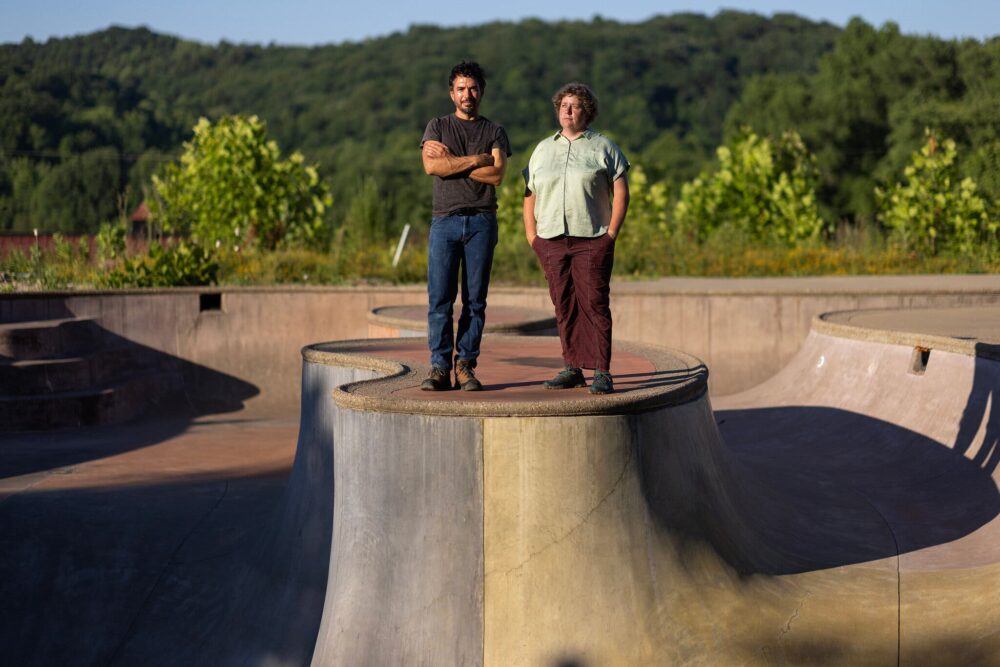
Trecartin (left) and Fitch, standing in the lazy river at their property in Ohio. Photograph by Maddie McGarvey
It was not the film’s plot that would resonate with viewers so much as Trecartin’s creation of a wholly original style, one that looked at once psychedelic and camp, decadent and D.I.Y. Long before being an influencer was seen as a potential career path and TikTok became public access television for a global audience, Trecartin found a way to use digital culture to create his own reality; he seemed to offer the clearest window yet inside the ever-shortening attention span of a mind reared first on MTV and then hurled into the increasingly fraught confines of online discourse. He and his longtime collaborator Lizzie Fitch, 42, a friend he met in the hallways of the RISD dorms (she appears in “A Family Finds Entertainment” as a character called Cosmos Bitch), showed the promise of the internet as a creative medium — while also hinting at its eventual excesses. In the film, and in the ones that followed, Trecartin presents a delirious, disjointed stream of dialogue that sounds like language feeding back on itself until it takes on a new shape. At various points in the film, characters make pronouncements, in a kind of valley girl upspeak, like “I believe somewhere there is something worth dying for and I think it’s amazing,” and talk directly to Trecartin’s consumer-grade camera, vamping in a kind of proto-selfie. He and Fitch were also among the first artists to gain a following through social media: With the help of his mother, he burned and hand decorated hundreds of DVDs of “A Family Finds Entertainment,” and shipped them out to people he met on Friendster, a nearly forgotten pre-Facebook social media network. The film soon became an early hit on a then-novel website called YouTube.
The DVD of “A Family Finds Entertainment” also moved through the art world in an almost viral manner. The artist Sue de Beer happened to see it at a party in Cleveland; she alerted Rachel Greene, then the head of the digital arts organization Rhizome, who gave a DVD to the gallerist Elizabeth Dee. She became Trecartin’s dealer and a co-producer of his films. After college, “I waited tables for one year, and then I just had an art career,” he says. In 2010 and 2011, his seven-movie installation “Any Ever” traveled to five separate museums.
For several years, Trecartin and Fitch moved from city to city — Providence, R.I., New Orleans, Oberlin, Ohio, Philadelphia, Miami, the Los Angeles area — setting up makeshift studios in houses they’d share together, filming with a roving group of collaborators and blurring the line between life and art. Before the age of 30, Trecartin had become the rare contemporary artist who was seen as a generational spokesperson, and whose work found an audience much wider than the usually parochial one that attends gallery and museum openings. The New Yorker critic Peter Schjeldahl described him as “the most consequential artist to have emerged since the 1980s.” The curator Massimiliano Gioni called his work “a cultural watershed.” On the occasion of a 2011 show at MoMA PS1 in New York, art critic Roberta Smith, writing in The New York Times, praised Trecartin and Fitch for their forward-thinking style. They “[shred] the false dichotomies and mutually demonizing oppositions that have plagued the art world for decades — between the political and the aesthetic, the conceptual and the formal, high and low, art and entertainment, outsider and insider, irony and sincerity, gay and straight.” The art business is not known for consensus, and yet there was general agreement that Trecartin was one of only a handful of artists who’d changed how we think about art in the early 21st century.
Following a celebrated show with Fitch at Andrea Rosen Gallery in the spring of 2016, to many casual art world onlookers, Trecartin’s once-frenetic volume of output slowed down. In 2017, Rosen, one of his U.S. dealers, stopped representing living artists. His work with Fitch was shown less and less frequently in America. Some people started to wonder what had happened to the artists. Then a year later, an article in The Athens News, a free weekly published in southeast Ohio, revealed that in 2016 Trecartin and Fitch had bought 32 acres of land in Canaan Township, population 5,134, a farming community about an hour and a half from Columbus; they moved there the following year. “Big-name artists are building a film set east of Athens, replete with ‘lazy river,’” read the headline.
Since then, there’s been scattered documentation of the past seven years Trecartin and Fitch have spent in Ohio, including a five-year-old video on YouTube produced by the skateboarding publication Thrasher Magazine, called “Bio in Ohio,” which, though it goes unmentioned, was shot on Trecartin’s property (Fitch gets a filming credit with no extra context added). It has 126,000 views and documents a group of professional skaters making the journey from California to Ohio to skate inside a massive structure that, depending on your worldview, either looks like a giant, empty luxury swimming pool or a piece of land art.
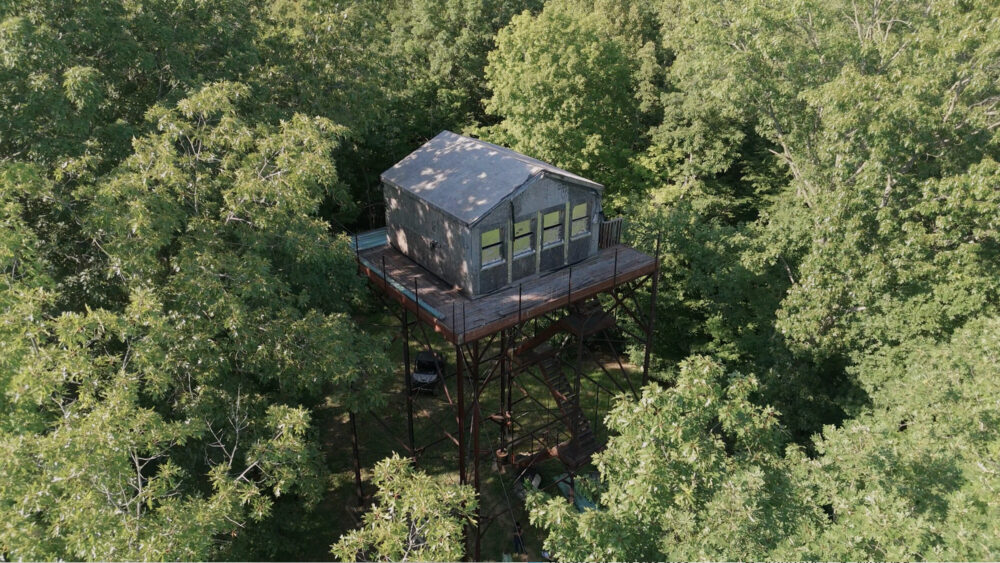
A watchtower built on the Ohio property, originally as a set for the film “Whether Line” (2019-present). Video by Maddie McGarvey
ONE AFTERNOON LAST May, Trecartin and Fitch picked me up from my hotel in Athens, Ohio, in their Volkswagen. They were burning palo santo and listening to a classic pop radio station. We stopped at two stores on the way to the property to pick up a tomato plant and a tin of Zyn, a brand of oral nicotine pouches. Trecartin’s land is directly across from a pasture, which sometimes floods to the point where a friend of the artists uses it for canoeing. Though they’ve had disputes with another neighbor, who, rankled by the construction, at one point took to blasting Christian rock in the direction of the artist’s property, for the most part relations with locals have been amicable. In anticipation of future flooding, the duo built a dirt platform to help a farmer keep his cattle safe. “The cows sometimes give you a stare, like, ‘I want to murder you,’” Trecartin says. Or maybe, he adds, it’s a look of “powerful wisdom.”
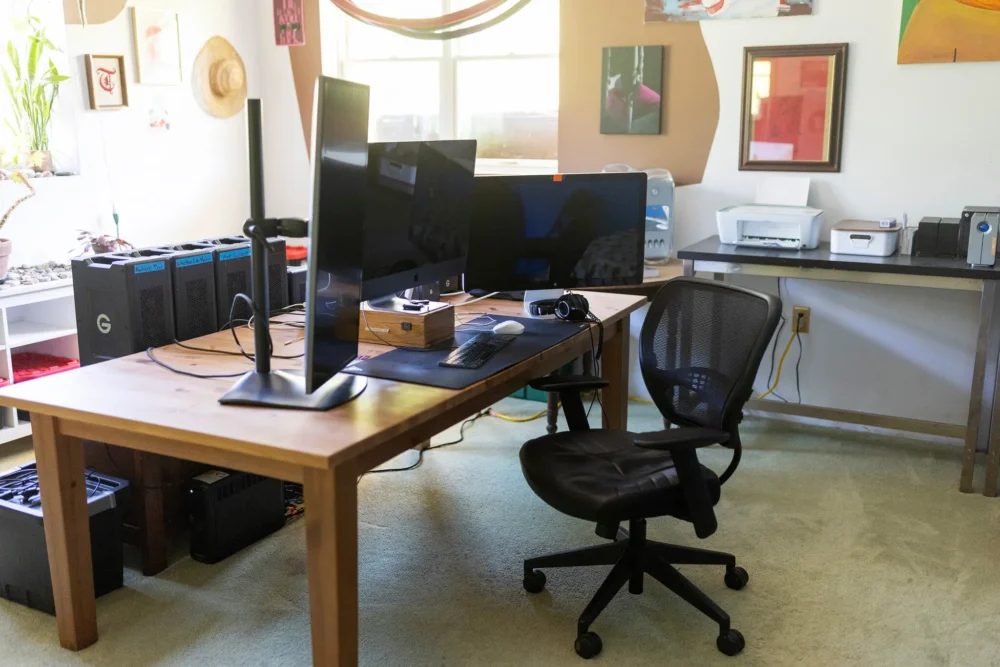
Trecartin’s editing room in Canaan Township, Ohio. Photograph by Maddie McGarvey
Trecartin, still boyish at 43, has gelled hair, a neat beard, and was wearing a colorful, multipatterned hoodie that reminded me of Zack Morris from “Saved by The Bell.” Fitch has a curly mop of hair. They each wore hiking shoes. They both grew up in Ohio, he in a family of steel-mill workers, and she in the college town of Oberlin, about three hours from Athens. But what brought them home was partly, it turns out, an invitation from the heart of the international art world. In 2015, they picked up a longstanding conversation with Astrid Welter, then the head of programming at Fondazione Prada, about a large-scale commission. “She was like, ‘Propose something everyone would say no to,’” Trecartin says. Their pitch was to create a kind of amusement park, built around what Trecartin described as “permanent sets.” When land became available near Athens, next door to property owned by Trecartin’s brother, Adam, a woodworker (he has helped to fabricate artworks and structures), it seemed fortuitous. The property sits outside of the town on unincorporated land, which means that permits aren’t required for building.
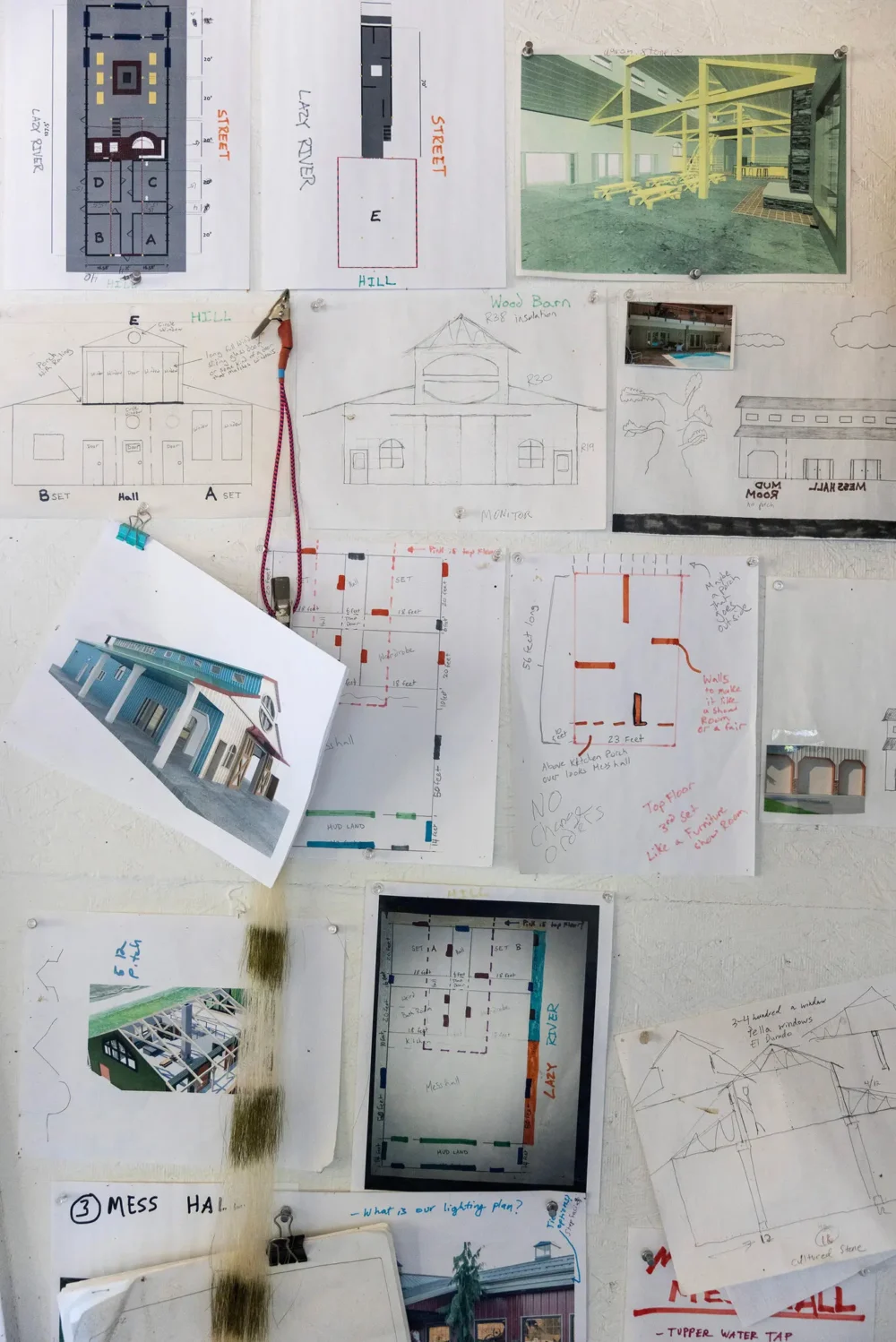
Plans and sketches related to the barn. Photograph by Maddie McGarvey
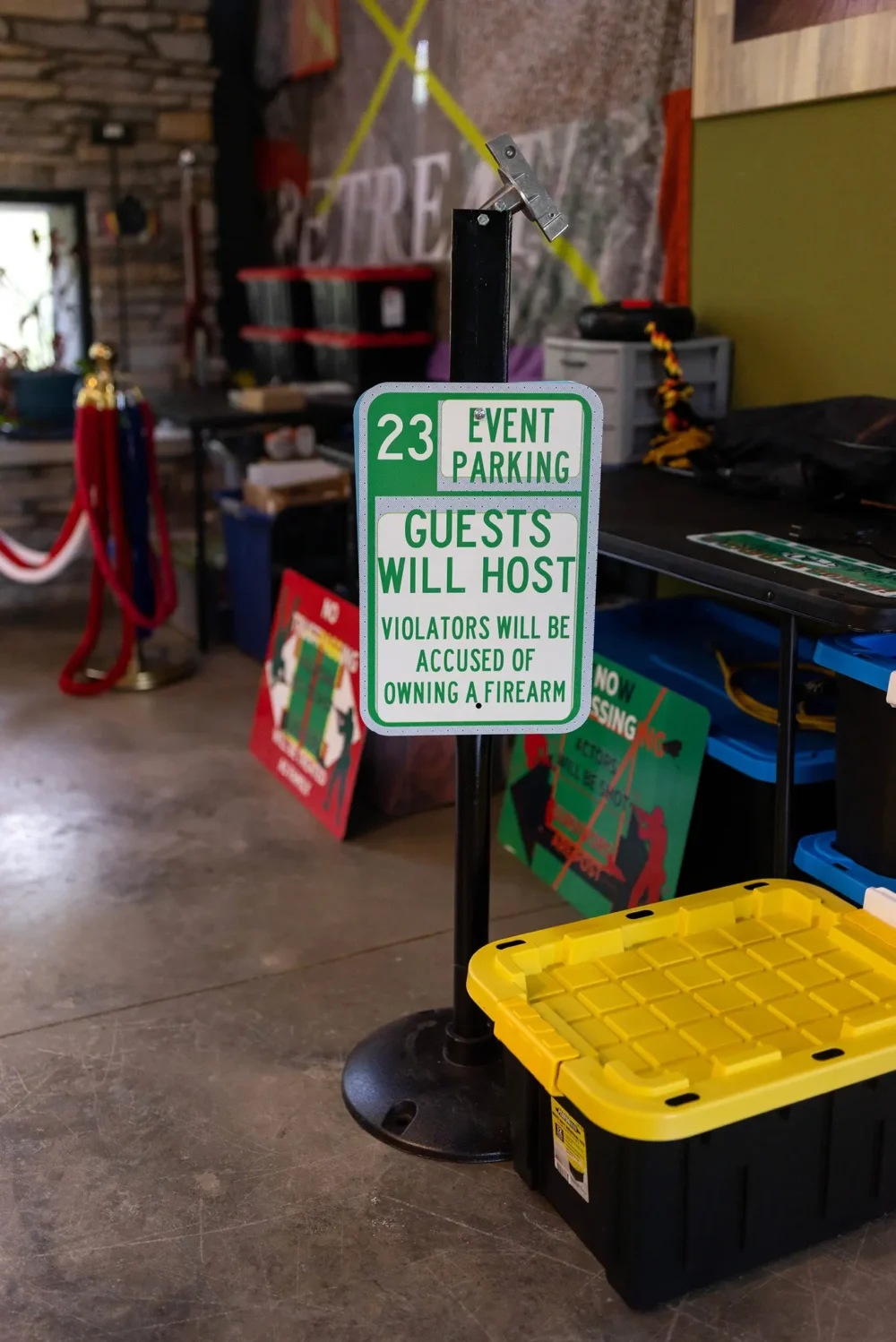
Some of Trecartin and Fitch’s props, including a sign used in the “Whether Line” film. Photograph by Maddie McGarvey
Since then, they’ve slowly been creating a combination film studio and water park, or maybe even a site-specific artwork. They first showed me a 80-by-40-foot barn, one of the main structures that Trecartin and Fitch built with the multimedia artist Rhett LaRue, for “Whether Line,” a still-in-progress feature-length movie about their years spent in Ohio; the artists plan to present a new edit of the film in a show at Prada’s Tokyo exhibition space beginning in October. (Trecartin and Fitch developed a working relationship in college that’s remained the same ever since: He’s the primary director, writer and editor, and Fitch collaborates on sculptural works, installations and bigger-picture production design.) A version of the movie, which stars Trecartin as a modestly attired character called Neighbor Girl, was presented in 2019 at Fondazione Prada in Milan. The barn sits on the land alongside, among other things, a pond, gardens, a separate house inhabited by Fitch and her wife, Saria Pastor, a roughly 60-foot-high wooden watchtower built with Trecartin’s brother, which was also used as a set for “Whether Line,” and the lazy river, which is concrete and up to 18 feet deep, though it’s never fully been filled with water. It sits behind the barn on the edge of a vast wooded area. Trecartin is a roller coaster fanatic, and at first he wanted to build actual amusement-park rides, though that dream quickly brushed up against logistical reality. “Now that I’m learning what it’s like to own something, [I think] we would be terrible at the upkeep. It would just become dangerous in a second,” Trecartin says. Instead, he and Fitch are focusing on what he calls “relaxing rides.”
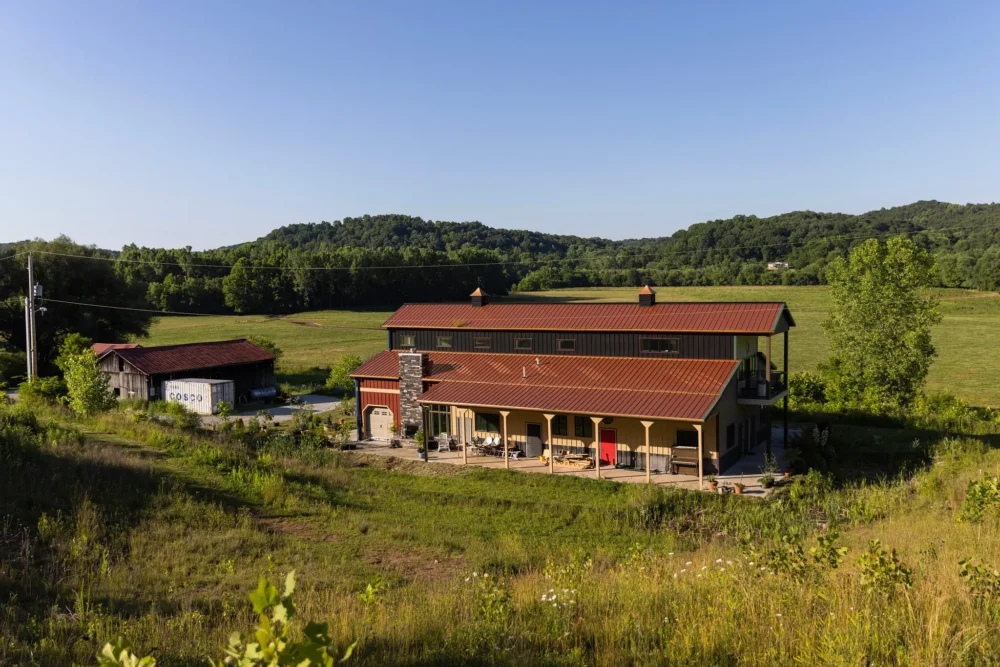
The barn, one of the main structures on the property, that was constructed for “Whether Line” and is where Trecartin lives and works. Photograph by Maddie McGarvey
The duo designed and constructed the barn using prefabricated parts from a company called Morton Buildings, ordering from a different section of the catalog for each side of the barn. “They were like, ‘So you want the color palette to be different on every side?’ And we’re like, ‘Yeah,’ ” Trecartin says. The barn has circular windows, which Trecartin compared to a cruise ship, as well as concrete flooring and a loft. The artist lives and works here. (Alison K Powell, an actor in many of Trecartin’s films, also lives in the building.) There’s a carpeted edit bay filled with art made by Trecartin’s friends. He sleeps in a room that contains a large bed frame taken from a 2016 photo shoot the artists did with Kendall Jenner and Gigi Hadid for W Magazine. There is a gray-water shower and a separate, almost-finished bathroom that includes two toilets next to each other. (Trecartin installed a single toilet, too, for “people who don’t want to poop with their friends.”) The one thing the space doesn’t have yet is a working septic system. “We’re not going to waste budget on a septic system when we’re building all this cool stuff,” Trecartin says. Fitch’s home on the property was built before they bought the land and includes working plumbing. Trecartin’s known for a relentless work pace, filming from dusk until dawn, and for marathon editing sessions — he once attempted, unsuccessfully, to work for 48 hours straight. “When I’m in a project, it’s like none of that stuff” — sleep, a working toilet — “matters anymore,” he says.
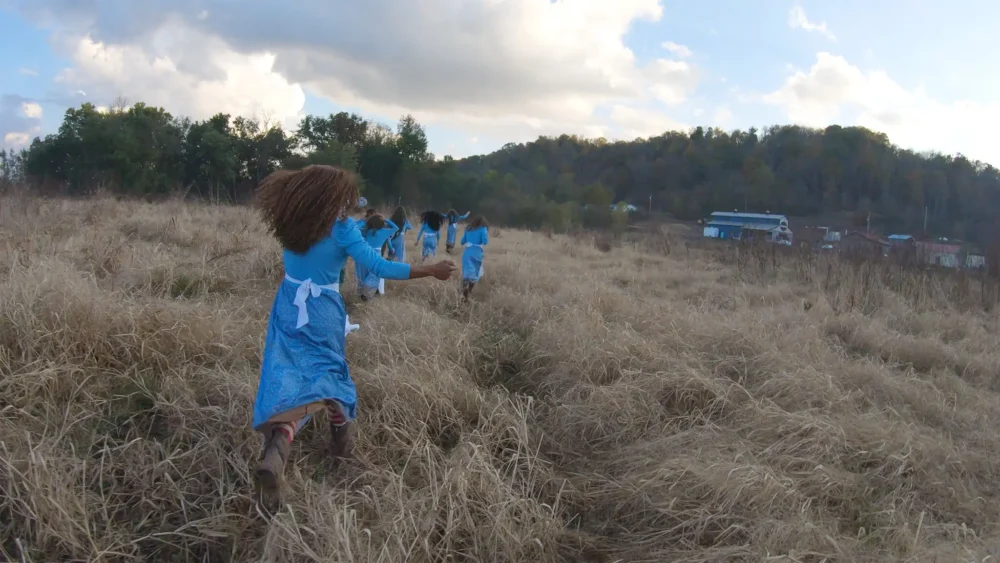
A still from “Whether Line,” which was filmed on the property in Ohio. Commissioned by Fondazione Prada. Courtesy of the artist, Sprüth Magers and Morán Morán
TRECARTIN, WHO GREW up moving frequently, says he thrives in new environments. “I like being in places that I’m not familiar with. And I always feel like I’m visiting everywhere,” he says. “Going somewhere that’s starkly different from where you just were puts all human constructs into this really loud relief.” For years, Trecartin and Fitch operated with a kind of fluidity that naturally conjoined with the techno-optimism that permeated much of the culture in the aughts. “There was a certain kind of idealism in the early 2000s that was like post-everything: We’re over it all, everything can become whatever it wants at any moment,” Trecartin says. As the years passed, though, he tells me that “the dark side” of that concept revealed itself. Media and human communication changed radically over the course of his early career, and a few years after “A Family Finds Entertainment,” his films were already darker and more unnerving. “The Re’Search” (2009-10) stars a gang of teenage girls who stare blankly into the camera while brandishing BlackBerrys like weapons. They spend much of the film plotting to kill their parents, who Trecartin says function as “proxies” for branding and marketing research. And at Trecartin and Fitch’s last major show in New York, in 2016, the tension that seemed to pulse below the surface of their work became more explicit. In a film called “Temple Time,” a kind of play on horror movie tropes in which a group of wholly unequipped ghost hunters raid a haunted Masonic temple, one character keeps saying, “My energy has been sucked away.”
The pace of their work has slowed considerably in Ohio. Surprisingly for two artists credited with understanding before anyone else how the internet was rewiring our brains, neither spends much time online anymore. Fitch, who also maintains a discrete sculptural practice, refers to the height of the pandemic as the duo’s “downtime years.” During that period, she did a lot of “walking, reading and watching TV” and spent very little time online. She took pleasure in working on creative projects with no set end point. Eventually she got a job at the post office. Trecartin grafted trees together in a sort of mutant-bonsai style; he drew; he ran home-brewed biohacking experiments on his body, some of them meant to combat aging. Both artists worked on projects for their larger friend group. They haven’t been earning as much as in years past. “When a big flood of money comes in, we’ll do things like fund a friend’s project, throw a party for our friends, fly people out to something,” he says. Many members of Trecartin’s circle have gone, at his urging, to the same psychic, a recently-deceased Philadelphia-based woman known as Cosmic Jackie, who told Trecartin that the period between 2019 and 2025 would come with financial hardships. “I was like, ‘Oh my God, this happened just like she said it would,’” he says. “I feel like we managed our money well. We just don’t have any money to show for our money that we had,” he said to me at one point, laughing.
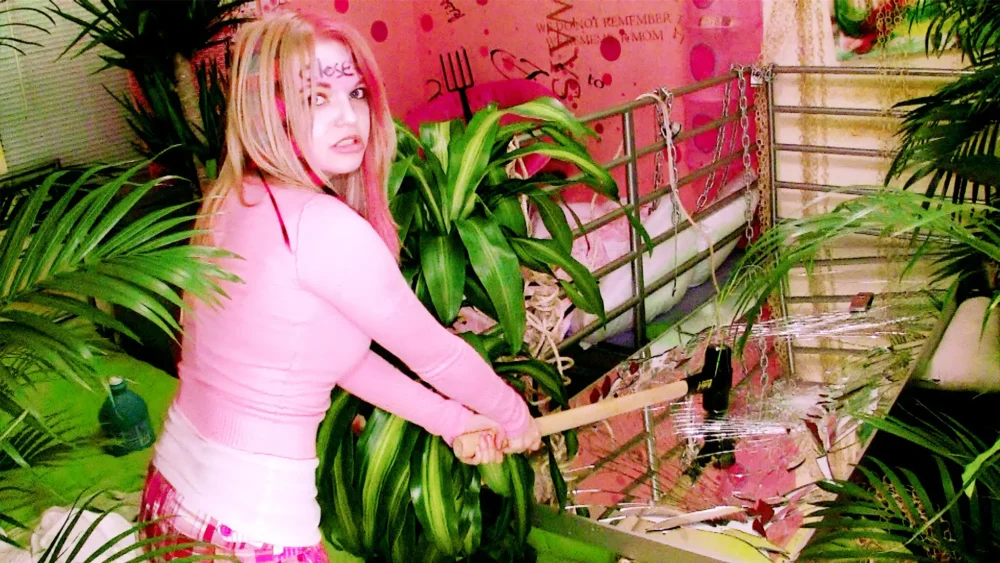
A still from “The Re’Search” (2009-10), one of Trecartin and Fitch’s films that helped make them chroniclers of digital culture. Courtesy of the artist, Sprüth Magers and Morán Morán
Lately, though, Trecartin and Fitch have been more active in the art world. They have new gallery representation, from the Los Angeles-based Morán Morán, which co-represents them alongside Sprüth Magers. They recently had a show in Aspen, Colo., devoted to their film soundtracks, and Trecartin designed a store for the fashion designer Kiko Kostadinov in Tokyo. Their new gallery is also helping them to formalize their space in Ohio — fund-raising and creating a board of directors, with the aim of eventually opening it to the public a couple of times a year.
Before I left Ohio, Trecartin and Fitch took me in an ATV to the watchtower. Besides having their own private studio for shooting and editing films, Trecartin and Fitch say they don’t know exactly how the space will develop. For a 2022 show on artist-run spaces at the Contemporary Arts Center in Cincinnati, they commissioned friends to make proposals for on-site conceptual projects: The documentary filmmaker Leilah Weinraub pitched a “seasonal straight-themed gay bar.” The fashion designer Telfar wants to make a store that operates on the honor system. The artist Precious Okoyomon is interested in creating a poisonous plant garden. Trecartin and Fitch plan to start an arts residency. Trecartin described his and Fitch’s philosophy as “let’s see how this mutates, and keep the door open for mutation,” which could also sum up the way they’ve lived and worked for the past 20 years. As Trecartin put it at one point while surveying their domain, “I just think one day we’re gonna know what it is.”
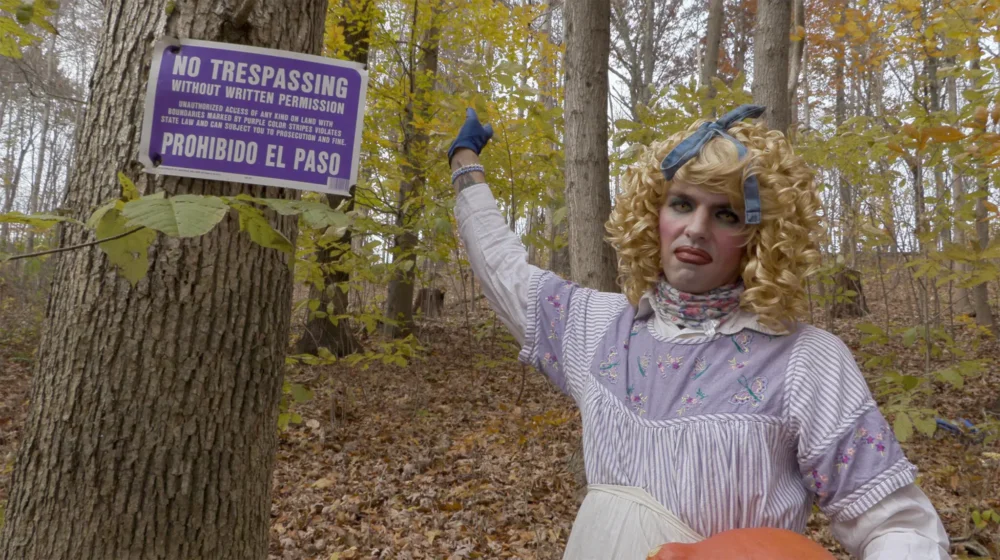
Another still from “Whether Line,” which has a plot loosely inspired by Trecartin and Fitch’s move to rural America. Commissioned by Fondazione Prada. Courtesy of the artist, Sprüth Magers and Morán Morán

